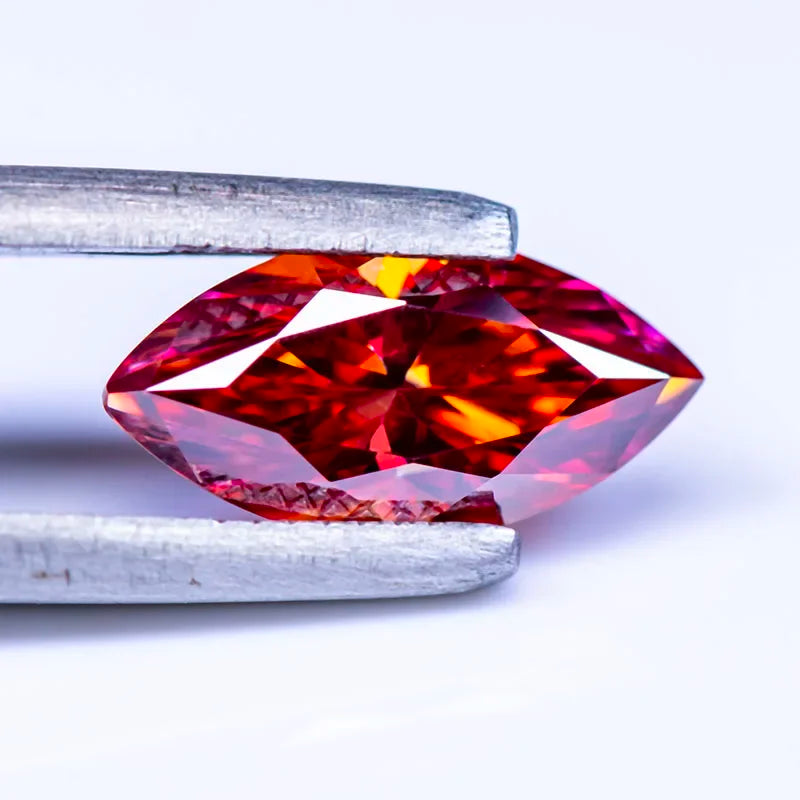Synthetic Diamond Types: CZ, Lab Diamonds, and Moissanite
Synthetic Diamond Types: CZ, Lab Diamonds, and Moissanite
At Gemitylab, we believe that everyone should have access to beautiful, high-quality diamonds, regardless of their budget. As demand for sustainable and ethical jewelry grows, synthetic diamonds have become an increasingly popular choice. When it comes to synthetic diamonds, there are three main types you’ll encounter: CZ (Cubic Zirconia), Lab Grown Diamonds, and Moissanite. Each has its own unique characteristics, and understanding the differences can help you choose the right one for your needs. In this blog post, we’ll explore these three synthetic diamond types and highlight their features, benefits, and differences.
What Are Synthetic Diamonds?
Synthetic diamonds are diamonds that are created in a laboratory setting, rather than being mined from the Earth. These diamonds are grown using high-tech processes that replicate the natural conditions under which diamonds form. While lab diamonds are chemically and physically identical to mined diamonds, CZ and moissanite are not true diamonds but are often used as diamond alternatives due to their similarity in appearance.
Now, let’s dive into the three main synthetic diamond types: CZ, Lab Diamonds, and Moissanite.
1. Cubic Zirconia (CZ)
What is CZ?
Cubic Zirconia, often abbreviated as CZ, is a synthetic gemstone made from zirconium dioxide. While it shares a similar appearance to a diamond, it is not technically a diamond. CZ is produced in a lab under controlled conditions, and it is often used as a more affordable alternative to diamonds.
Characteristics of CZ
- Appearance: Cubic Zirconia closely resembles a diamond because it is colorless and brilliant. It can be cut into various shapes, just like a diamond, and often appears sparkly under light.
- Hardness: CZ is much softer than a diamond, with a hardness rating of 8.5 on the Mohs scale. In comparison, diamonds have a hardness of 10. This means that CZ is more prone to scratches and wear over time.
- Price: Cubic Zirconia is significantly more affordable than diamonds and is often used in costume jewelry or as a budget-friendly option for engagement rings.
Pros and Cons of CZ
Pros:
- Affordable: The most significant advantage of CZ is its affordability.
- Sparkly: Its brilliance and clarity mimic the appearance of diamonds, making it an attractive option for those on a budget.
Cons:
- Durability: Since CZ is softer than diamonds, it is more prone to scratching and losing its luster over time.
- Not a True Diamond: Some people prefer to invest in a more durable, long-lasting diamond alternative.
2. Lab Grown Diamonds
What Are Lab Grown Diamonds?
Lab grown diamonds, also known as synthetic diamonds or cultured diamonds, are real diamonds created in a laboratory using advanced technology. These diamonds are made through two main methods: High Pressure High Temperature (HPHT) and Chemical Vapor Deposition (CVD). Both methods replicate the conditions under which natural diamonds form, and as a result, lab diamonds are virtually indistinguishable from mined diamonds.
Characteristics of Lab Grown Diamonds
- Appearance: Lab grown diamonds look identical to mined diamonds, sharing the same brilliance, fire, and sparkle. They are graded using the same 4Cs as natural diamonds: cut, color, clarity, and carat weight.
- Hardness: Lab grown diamonds are just as hard as natural diamonds, with a rating of 10 on the Mohs scale, making them incredibly durable and resistant to scratching.
- Price: Lab diamonds are generally more affordable than mined diamonds because they don’t involve the cost of extraction and transportation. However, they are still more expensive than CZ or Moissanite.
Pros and Cons of Lab Grown Diamonds
Pros:
- Sustainability: Lab grown diamonds are more eco-friendly and ethically produced than mined diamonds, making them an attractive option for environmentally conscious consumers.
- Authenticity: They are real diamonds in every sense, sharing the same chemical composition and structure as mined diamonds.
- Affordability: Lab grown diamonds offer an affordable alternative to mined diamonds without sacrificing quality.
Cons:
- Cost: While more affordable than natural diamonds, lab grown diamonds are still pricier than other alternatives like CZ and Moissanite.
3. Moissanite
What is Moissanite?
Moissanite is a naturally occurring mineral composed of silicon carbide. It was first discovered in 1893 by Henri Moissan, a French chemist, in a meteor crater. Today, Moissanite is lab-created for use in jewelry. While it is not a diamond, it is often chosen as a diamond alternative due to its incredible brilliance and fire.
Characteristics of Moissanite
- Appearance: Moissanite is known for its exceptional brilliance, which exceeds that of diamonds. It has more fire (colored flashes of light) than diamonds, making it appear even more sparkly under certain lighting conditions.
- Hardness: With a hardness of 9.25 on the Mohs scale, Moissanite is slightly softer than diamonds but still very durable and resistant to scratching.
- Price: Moissanite is less expensive than lab diamonds and natural diamonds, making it a more budget-friendly alternative.
Pros and Cons of Moissanite
Pros:
- Brilliance: Moissanite has a higher refractive index than diamonds, meaning it sparkles more intensely.
- Affordability: Moissanite is an excellent option for those who want the look of a diamond without the hefty price tag.
- Durability: With its hardness rating of 9.25, Moissanite is suitable for everyday wear and is highly resistant to scratching.
Cons:
- Different Appearance: Although Moissanite sparkles brilliantly, its overall appearance is different from a diamond. The flashes of color (fire) can be more noticeable than those in diamonds, which some people may find less appealing.
- Not a Diamond: If you’re specifically looking for a diamond, Moissanite is not a true diamond, even though it mimics the look of one.
Which Synthetic Diamond Type Is Right for You?
Choosing the right synthetic diamond depends on your preferences and budget. Here’s a quick comparison:
- CZ: If you’re looking for an affordable, sparkly option for costume jewelry or budget-conscious purchases, CZ is a great choice.
- Lab Grown Diamonds: For those who want a true diamond that is ethically sourced, durable, and more affordable than mined diamonds, lab grown diamonds are the perfect option.
- Moissanite: If you love brilliance and fire and want a budget-friendly alternative to diamonds, Moissanite could be the ideal choice.
At [Your Jewelry Store Name], we offer a wide selection of Synthetic Diamond Types: CZ, Lab Diamonds, and Moissanite to suit your style and needs. Whether you’re looking for an engagement ring, earrings, or a statement piece, we’ve got something for everyone.
For more information or to browse our collection, check out our Home page. If you have any questions, feel free to reach out to us at info@gemitylab.com, or connect with us on Facebook.




